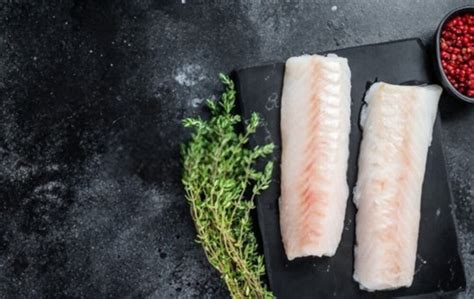
Pollock, a mild and readily available fish, is gaining popularity as a budget-friendly alternative to lobster, offering a similar sweet flavor profile at a fraction of the cost. Often overshadowed by more prominent seafood choices, pollock is now being recognized for its versatility, sustainability, and affordability, making it an appealing option for consumers looking to enjoy seafood without breaking the bank.
Pollock, often found in fish sticks and fast-food sandwiches, is now stepping into the culinary spotlight as chefs and home cooks alike discover its potential. According to a recent article in Yahoo! Lifestyle, pollock boasts a delicate, slightly sweet taste that can mimic the flavor of lobster when prepared correctly. This revelation comes at a time when the cost of lobster and other seafood delicacies continues to rise, placing a strain on household budgets. “If you want a lobster roll but don’t want to pay lobster prices, try swapping in cooked pollock,” the article suggests.
The increasing recognition of pollock highlights a broader trend towards sustainable and economical eating habits. As consumers become more conscious of their food choices and their impact on the environment and their wallets, less-celebrated ingredients like pollock are receiving a second look. Pollock’s mild flavor makes it a versatile ingredient suitable for a wide range of dishes, from simple pan-fried fillets to elaborate seafood stews.
Affordability and Accessibility
One of the key drivers behind pollock’s rising popularity is its affordability. Compared to lobster, which can command prices of $20 or more per pound, pollock typically retails for a fraction of that cost, often under $5 per pound, depending on the region and the retailer. This significant price difference makes pollock an accessible option for families and individuals on a budget who still want to incorporate seafood into their diets.
Moreover, pollock is widely available in most supermarkets and grocery stores, both fresh and frozen. Its accessibility further contributes to its appeal as a convenient and reliable source of protein. The frozen variety is particularly advantageous, as it allows consumers to stock up and use the fish as needed, reducing food waste and ensuring a consistent supply.
Sustainability and Responsible Fishing Practices
Beyond its affordability and accessibility, pollock also scores high marks for sustainability. The majority of pollock harvested in the United States comes from the Bering Sea and the Gulf of Alaska, where it is managed under strict regulations designed to ensure the long-term health of the fish populations and the marine ecosystem. These regulations, overseen by the National Oceanic and Atmospheric Administration (NOAA), include quotas, gear restrictions, and habitat protection measures.
The Marine Stewardship Council (MSC), an independent non-profit organization that sets standards for sustainable fishing, has certified many pollock fisheries as sustainable. This certification provides consumers with confidence that the pollock they are purchasing has been harvested in an environmentally responsible manner. Choosing MSC-certified pollock supports sustainable fishing practices and helps to protect marine resources for future generations.
Culinary Versatility and Preparation Tips
Pollock’s mild flavor and flaky texture make it an incredibly versatile ingredient in the kitchen. It can be prepared in a variety of ways, including baking, frying, grilling, poaching, and steaming. Its delicate taste pairs well with a wide range of seasonings and sauces, from simple lemon and herbs to more complex Asian-inspired marinades.
One popular way to prepare pollock is to bake it with a sprinkle of breadcrumbs and a drizzle of olive oil. This simple method allows the natural flavor of the fish to shine through while creating a crispy, golden-brown crust. Alternatively, pollock can be pan-fried in butter or oil for a quick and easy meal.
For those looking to replicate the taste of lobster, the Yahoo! Lifestyle article suggests poaching pollock in a flavorful broth. Poaching helps to retain the fish’s moisture and imparts additional flavor. The cooked pollock can then be used in lobster rolls, seafood salads, or other dishes where lobster is typically used.
Another option is to use pollock in fish tacos. Its mild flavor complements the spicy and savory elements of traditional taco recipes. Simply grill or pan-fry the pollock and serve it in tortillas with your favorite toppings, such as shredded cabbage, pico de gallo, and a creamy sauce.
Health Benefits of Pollock
In addition to its affordability, sustainability, and culinary versatility, pollock also offers a number of health benefits. It is a lean source of protein, providing essential amino acids that are necessary for building and repairing tissues. Pollock is also low in fat and calories, making it a healthy choice for those watching their weight.
Furthermore, pollock is a good source of omega-3 fatty acids, which are beneficial for heart health, brain function, and reducing inflammation. These essential fats are not produced by the body and must be obtained through diet. Including pollock in your diet can help you meet your omega-3 fatty acid needs.
Pollock is also a source of several important vitamins and minerals, including vitamin B12, selenium, and iodine. Vitamin B12 is essential for nerve function and red blood cell production. Selenium is an antioxidant that helps to protect cells from damage. Iodine is necessary for thyroid hormone production, which regulates metabolism.
Overcoming the Stigma
Despite its many advantages, pollock has historically suffered from a negative perception, largely due to its association with processed foods like fish sticks. However, as consumers become more aware of its potential and its many benefits, this perception is beginning to change.
Chefs and food bloggers are increasingly showcasing pollock in creative and innovative recipes, demonstrating its versatility and deliciousness. Food publications are also highlighting its sustainability and affordability, helping to raise its profile among consumers.
The key to overcoming the stigma surrounding pollock is to educate consumers about its true potential and to provide them with delicious and easy-to-prepare recipes. By showcasing its many advantages, we can help to transform pollock from an underappreciated ingredient into a culinary star.
Consumer Perception and Marketing Strategies
The perception of pollock is a crucial factor in its acceptance as a lobster alternative. Many consumers associate pollock with lower-quality processed foods, which can create a negative bias. Effective marketing strategies are essential to reshape this perception and highlight the fish’s positive attributes, such as its mild flavor, affordability, and sustainability.
One approach is to emphasize pollock’s versatility in cooking. Instead of solely focusing on its use in fish sticks, marketing campaigns can showcase gourmet recipes featuring pollock as a main ingredient. Collaborations with chefs and food bloggers can help to create appealing and innovative dishes that demonstrate the fish’s potential.
Another strategy is to highlight pollock’s sustainability credentials. Emphasizing that it is harvested from well-managed fisheries and certified by organizations like the Marine Stewardship Council (MSC) can appeal to environmentally conscious consumers. Transparency about the fish’s origin and fishing practices can build trust and encourage consumers to choose pollock over less sustainable options.
Retailers can also play a significant role in promoting pollock. Displaying it prominently in seafood sections, offering recipe cards, and providing cooking demonstrations can help to educate consumers and encourage them to try it. Clear labeling that emphasizes its flavor profile and cooking suggestions can also make it more appealing.
The Impact on the Seafood Industry
The growing popularity of pollock could have significant implications for the seafood industry. As demand for pollock increases, it could help to alleviate pressure on overfished species and promote more sustainable fishing practices.
Increased consumption of pollock could also benefit fishing communities and processors that rely on the pollock fishery. By creating new markets and opportunities, it can help to support local economies and ensure the long-term viability of the industry.
However, it is important to manage the pollock fishery responsibly to ensure that it remains sustainable. Continued monitoring of fish populations, enforcement of regulations, and investment in research are essential to protect this valuable resource.
Future Trends and Innovations
The future of pollock looks bright, with several emerging trends and innovations that could further enhance its appeal and versatility.
One trend is the development of new pollock-based products, such as value-added meals and snacks. These products can cater to busy consumers who are looking for convenient and healthy meal options.
Another innovation is the use of pollock in surimi, a processed fish paste that is used to make imitation crab meat and other seafood products. Surimi made from pollock is a sustainable and affordable alternative to surimi made from other fish species.
Advances in aquaculture could also play a role in the future of pollock. Although most pollock is currently wild-caught, there is growing interest in developing sustainable aquaculture methods for this species.
Conclusion
Pollock is a versatile, affordable, and sustainable seafood option that is gaining recognition as a budget-friendly alternative to lobster. Its mild flavor and flaky texture make it a versatile ingredient in the kitchen, and its numerous health benefits make it a nutritious choice for consumers. By overcoming the stigma associated with processed foods and highlighting its many advantages, pollock can become a staple in kitchens across the country. Its increasing popularity can also contribute to more sustainable fishing practices and support fishing communities. As consumers become more conscious of their food choices, pollock is poised to become a culinary star, offering a delicious and responsible way to enjoy seafood.
Frequently Asked Questions (FAQ) about Pollock
1. What exactly is pollock and where does it come from?
Pollock refers primarily to two species of fish: Alaska pollock ( Gadus chalcogrammus) and Atlantic pollock (Pollachius virens). Alaska pollock, the more common of the two, is primarily harvested in the Bering Sea and Gulf of Alaska. Atlantic pollock, also known as saithe, is found in the North Atlantic Ocean. Both species are members of the cod family and are known for their mild flavor and flaky texture. Most commercially available pollock is wild-caught and managed under strict regulations to ensure sustainability. The Yahoo! Lifestyle article emphasizes the growing recognition of pollock as a versatile and affordable seafood option.
2. How does pollock compare to lobster in terms of taste and texture?
While not an exact match, pollock can mimic the flavor and texture of lobster when prepared correctly. Pollock has a mild, slightly sweet taste that is similar to lobster. Its flaky texture also lends itself well to dishes where lobster is typically used. According to the Yahoo! Lifestyle article, swapping cooked pollock into a lobster roll can be a budget-friendly alternative without sacrificing too much on taste. Proper cooking methods, such as poaching in a flavorful broth, can enhance the resemblance to lobster.
3. Is pollock a sustainable seafood choice?
Yes, pollock is generally considered a sustainable seafood choice, especially when harvested from well-managed fisheries. The Alaska pollock fishery, in particular, is known for its responsible management practices, overseen by NOAA. Many pollock fisheries are certified by the Marine Stewardship Council (MSC), indicating that they meet strict standards for sustainability. Choosing MSC-certified pollock supports environmentally responsible fishing practices and helps to protect marine resources. Consumers can look for the MSC label on pollock products to ensure they are making a sustainable choice.
4. How can I prepare pollock to make it taste more like lobster?
To enhance the lobster-like qualities of pollock, poaching is a recommended cooking method. Poaching the pollock in a flavorful broth, such as a court bouillon or a seafood stock, can impart additional flavor and help to retain its moisture. The Yahoo! Lifestyle article specifically suggests this method for replicating the taste of lobster in dishes like lobster rolls. After poaching, the pollock can be seasoned with herbs, lemon juice, and butter to further enhance its flavor. Avoid overcooking pollock, as this can make it dry and less appealing.
5. What are some healthy ways to incorporate pollock into my diet?
Pollock is a lean source of protein, low in fat and calories, and rich in omega-3 fatty acids. It can be incorporated into your diet in a variety of healthy ways. Baking pollock with a sprinkle of breadcrumbs and a drizzle of olive oil is a simple and nutritious option. Pan-frying it in a small amount of oil or butter is another quick and easy method. Pollock can also be used in fish tacos, seafood salads, and fish stews. Adding vegetables and whole grains to your pollock dishes can further enhance their nutritional value. Avoid deep-frying pollock, as this can add unnecessary calories and unhealthy fats. Steaming or grilling are also good healthy cooking options.









